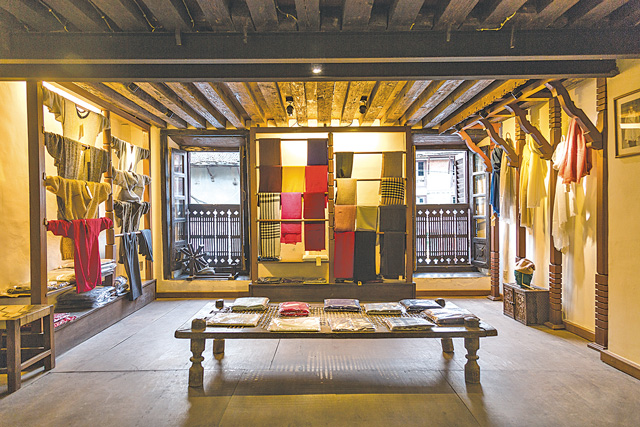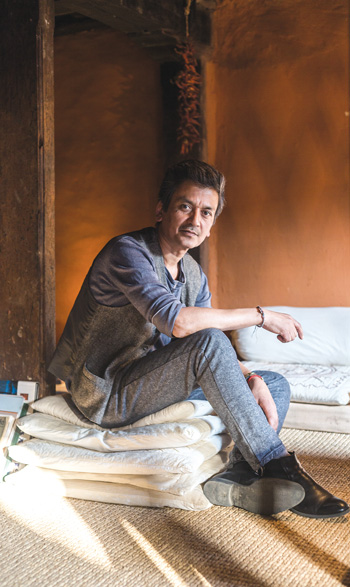“Nepali artisans are among the most gifted in the world, and we seek to prove it by creating superior products that match modern aesthetics with traditional skills.”
 Hidden in the alleys of Mangalbazar, Yala Gallery exhibits local fine art and craft in an old heritage edifice. Consisting of the traditional bahal, and embellished with wooden aankhijhyal, stairs, and doors, it flaunts its unique handcrafted bric-a-brac in a conventional Newari building. In Newari, “Yala” means Patan, whereas “Ya” is an endearing term, hence, the founder and creative director of Yala Craft, Pravin Chitrakar—native to Patan, and passionate about art and culture—regards the name to be just right for his gallery. Engaged in a skill-based business since 1992, he believes, “Nepali artisans are among the most gifted in the world, and we seek to prove it by creating superior products that match modern aesthetics with traditional skills.”
Hidden in the alleys of Mangalbazar, Yala Gallery exhibits local fine art and craft in an old heritage edifice. Consisting of the traditional bahal, and embellished with wooden aankhijhyal, stairs, and doors, it flaunts its unique handcrafted bric-a-brac in a conventional Newari building. In Newari, “Yala” means Patan, whereas “Ya” is an endearing term, hence, the founder and creative director of Yala Craft, Pravin Chitrakar—native to Patan, and passionate about art and culture—regards the name to be just right for his gallery. Engaged in a skill-based business since 1992, he believes, “Nepali artisans are among the most gifted in the world, and we seek to prove it by creating superior products that match modern aesthetics with traditional skills.”
But, before anything else, Chitrakar considers changing the perception of Nepali handicrafts to be most crucial to the industry, which he thinks has already begun with the current generation. “Firstly, people need to learn to appreciate handicrafts as an art, and then believe in its potency, and finally, work to further glorify it,” he shares. The idea is to dignify the name of Nepali handicrafts and attract more professionals into the industry. He especially stresses on involving “educated” people, as he finds lack of professionalism a big bane to the sector.
 “Most of the people are business-oriented, with money as their driving force, which is no doubt a smart thing to do at a personal level. The owners of handicraft shops here in Patan, all they wait is for a tourist to visit their shop so that they can seize the opportunity to milk as much money as they can. But, for the greater good of the handicraft industry, what we lack is passion. Passion to dig into core values,” he asserts. He believes that the status of handicraft business in Nepal can only progress with the association of critical young minds who bring with them the essentials of passion, creativity, and ideas.
“Most of the people are business-oriented, with money as their driving force, which is no doubt a smart thing to do at a personal level. The owners of handicraft shops here in Patan, all they wait is for a tourist to visit their shop so that they can seize the opportunity to milk as much money as they can. But, for the greater good of the handicraft industry, what we lack is passion. Passion to dig into core values,” he asserts. He believes that the status of handicraft business in Nepal can only progress with the association of critical young minds who bring with them the essentials of passion, creativity, and ideas.
Chitrakar dreams of Nepali handmade products reaching the heights as those of Mexico, Turkey, and Italy. But he considers it unachievable without constructing a good image about Nepali handicrafts, for which a great deal of thought should be put into each of its stories. “I feel sad when I see these works of art wrapped in crumpled newspapers and given away with its value reduced to mere rupees. Nobody bothers about the image and story of the craft. For us, the lazy Nepalis, it’s all about making easy money. And, this is where I believe a lot of things went wrong,” he opines.
He believes that every piece of art has a unique story to tell, be it about its origin, its making process, or any other aspect. He conjectures, “Even when you tell a single foreigner the story of the handicraft he buys, rest assured he will retell it to around a hundred others throughout his lifetime.” A non-believer in traditional advertising and marketing schemes, “Let people talk about my work” is what the maverick says. So, the purpose is not to sell too many, but to those who will appreciate and talk about the story behind the art.
Chitrakar believes that, at this point, Western countries are fed up of bulk products, including those from China, and claims now to be an excellent time for the handicraft industry to tap and build a good position for its finer goods in the international market. But, the standing of Nepalese handicraft industry is far from desired. “As opposed to the then 15 years of conflict period, the handicraft sector should have advanced a thousand times more, but because of unsatisfactory effort from the locals, workers, as well as the government, this is not the case,” he adds. Although he believes that he is not the right person to suggest policies to the government, he would definitely like the government to make things easier for the handicraft business, with less of unnecessary meddling. He wants the government to support promotionally, as well as in terms of rudimentary infrastructure like electricity, gas, fuel, and transportation. Also, as setting up an enterprise in Nepal is not a piece of cake, he suggests that the government should make the procedure of investment and loan simple and hassle-free. Only then can the handicraft industry grow to its potential stature that it deserves to attain.
Today, Yala Craft exports its handmade jewelry, garments, paper, buttons, ceramics, and decorative art, among other products, to Germany, Canada, Japan, Scandinavia, the U.S.A., and many other countries throughout the world. It has been providing a platform for designers and independent artists to explore their craft while staying true to its motto of “Contemporizing Tradition”. “My plea to everyone involved in this industry would be to open up about what you are doing. Don’t worry about people copying your work, let people copy you, in the end, you will be the leader,” he says. He aspires that one day, apart from Mt. Everest and Lord Buddha, the handicraft sector will also introduce Nepal to the world, and hopefully “Handmade in Nepal” will be a luminous label across the globe.










